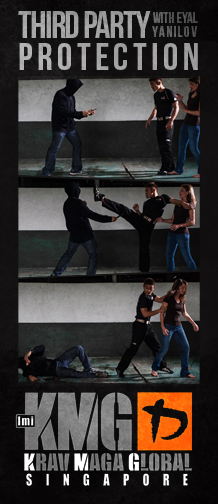Loading the content... Loading depends on your connection speed!
About Krav Maga

Krav Maga literally means “contact combat,” and like what its name suggests, it is a self-defense combat system that can be applied in real-life situations. It is not a traditional martial art or sport, but a practical and realistic system that will teach its students how to avoid, prevent, deter and deal with all types of violent confrontations.
KRAV MAGA’S MISSION
Krav Maga aims to impart skills through the understanding of the principles behind each defense or attack move. Students learn to hone their instincts through drills that emphasize quick thinking and at the same time, reinforce muscle memory. In a short space of time, students will pick up skills that are practical and useful when facing life-threatening situations.
Those who have trained in Krav Maga see vast improvements in their physical fitness and agility. Not only that, but students also learn to make quicker decisions in tense situations, and learn to cope in a stressful, fast-paced environment. This translates to all aspects of their lives, including work and play.

PRACTICAL AND REALISTIC
Krav Maga is composed of three pillars: Firstly, protecting and defending yourself, secondly, fighting skills and tactics, and thirdly, protection of another person. Students will gain a foundation in all three aspects of Krav Maga, and be able to apply it if necessary.
This is because all of the techniques and principles in Krav Maga are taught with real-life scenarios in mind. Students learn to deal with all types of conflict situations in all types of environments, including open or confined spaces, in a car or on public transport, in water, in low-light conditions and even on shaky ground.
Students also learn to handle violent confrontations when it arrives unexpectedly – whether they are sitting or lying down, when in a moving vehicle, or with a loved one, they will know how to take advantage of objects and the environment around them to bring themselves to safety.
FOR EVERYONE AND ANYONE
Krav Maga is suitable for all and can be adapted to meet the needs of men, women, children and mature adults. KMG’s certified instructors assess each trainee’s current capabilities and push trainees at a level that is appropriate, yet challenging enough to boost their physical and mental fitness. With the guidance of our instructors, students can reach their own goals at a pace appropriate to their abilities.
For combat-trained organisations looking to hone their finesse, KMG also has specific curriculums including tactical adaptations to meet the ever-growing needs of Military Units, Anti-Terrorist Groups, Special Units, Undercover Officers, Close Protection Agents, Correctional Officers, Air Marshalls and much more.
Origins of Krav Maga
Krav Maga was first developed as an unarmed combat system. Founded by Imi Lichtenfeld, an internationally renowned boxer, wrestler and gymnast, Krav Maga derives its movements and techniques from various martial arts sports, including boxing, Muay Thai, Wing Chun, Judo, Jujutsu, and wrestling. During his stint with the military, Lichtenfeld developed and refined efficient techniques for defending and attacking himself in threatening situations, which he passed on to fellow recruits.
Eyal Yanilov, one of Lichtenfeld’s closest disciples, has since adapted Krav Maga to meet the needs of civilians, law enforcement officers and security personnel all around the world. Today, Krav Maga is widely recognized as the most comprehensive self-defense system in the world that has a focus on real-life situations.
KRAV MAGA TRAINING LEVELS
An essential part of Krav Maga training is its structured lessons and ranking that enables students to easily grasp what is expected of them. The Krav Maga curriculum is divided into grades and levels, whether it is for civilians, military soldiers, law enforcement and security officers, bodyguards or members of special units.
The Krav Maga training curriculum includes:
- Self Defense
- Fighting Skills and tactics
- Third party Protection
- Avoidance, Prevention, De-escalation
- Ability to defend attacks from various angles and direction
- Execution of attacks and counter attacks from all positions and postures
- Use of all sorts of common objects for defensive purposes
- Defending all unarmed attacks: punches, strikes and kicks
- Releases from all sorts of grabs and holds
- Defending and disarming all armed attacks and threats from sharp objects, long blunt weapons and firearms
- Dealing with multiple attackers
- Physical and mental control
- The ability to execute techniques under stressful condition
To see the full Krav Maga units of the curriculum, click HERE.
There are also specific curriculums available for government bodies and security forces, including infantries, anti-terrorism units, law-enforcement units, and peace keeping missions.
Krav Maga Global Singapore Pte Ltd
Upper Serangoon Shopping Centre, 756 Upper Serangoon Road
#02-02
Singapore 534626
6282 2721
Krav Maga Global (KMG) was founded in 2010, and has since then been in the forefront of Krav Maga development and educational programs. KMG has more than 60 affiliated countries and over 1.500 instructors globally. Any and all contents on this webpage is protected by copyright law and all infringements will be prosecuted.




